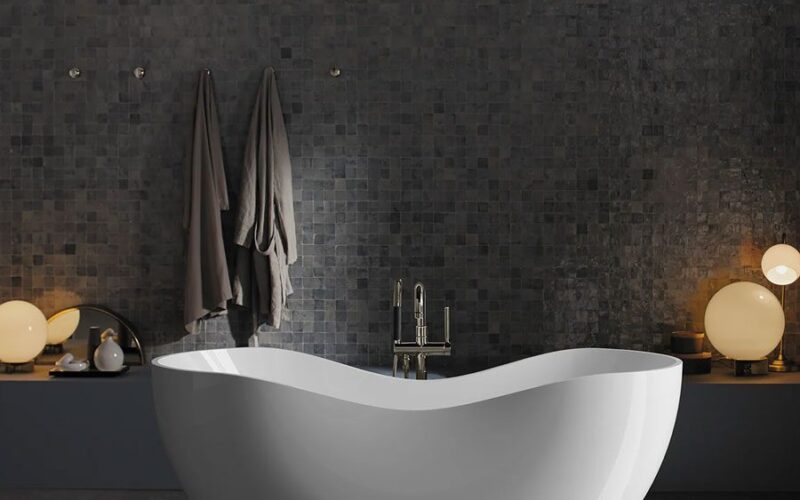Acrylic Tubs: Everything You Need to Know
Durability, versatility, heat retention, and smoothness… with a realistic price tag. Acrylic tubs are easy on the attention, your body, and the wallet.
There’s grounds this tub material is a well liked on the marketplace. It’s comfortable, low-maintenance, warm, and lightweight, and, best of all, it’s affordable. Here’s what you need to know before you get an acrylic bathtub.
An acrylic bathtub is a bathtub formed by vacuum sheets of acrylic, which is then reinforced with fiberglass. The benefits of this design method is that you will be afforded all the positives of fiberglass with the acrylic reinforcing the negatives, mainly the less than ideal strength of fiberglass as a material. Fiberglass is also a porous material, this means it’ll absorb water regularly, resulting in warping and lower lifespan of the material. Using the inclusion of acrylic, an acrylic bathtub is no longer porous with the sheets providing enough of a barrier between your water and the bathtub itself.
Shapes, materials sizes, and weights of acrylic tubs
As it is actually a reinforced fiberglass bathtub, acrylic bathtubs like a plethora of designs, shapes, and sizes. The three most usual shapes would be your typical alcove design, which functions as the typical drop-in design with the average size of 60 inches in length, 32 inches wide and 18 inches tall. That is accompanied by the oval or other circular shapes which can be an extremely popular freestanding design with typically 60 inches in length, 41 inches in width and a height of 24 inches. For individuals who want a far more luxurious setup, there is the corner bathtub which takes the condition of a full square and predominately is the starting place for a hot tub like a bathtub. The average size of a corner bathtub is usually 60 inches long, 60 inches wide with a height of 22 inches. However, since Acrylic is so readily flexible as well as affordable, there are numerous shapes you can manufacture that fit ranging from these three spectrum lacking any enormous hit on your financial budget. Also, since fiberglass has already been a lightweight material, the added reinforcement with colored acrylic does not add too much additional weight, making this material the lightest on the marketplace, allowing for easier install and repair jobs down the road. So, whether you will want traditional freestanding or a drop-in, an acrylic bathtub can certainly be made to match your requirements at a realistic price.
What’s an acrylic tub?
Acrylic tubs are constructed of vacuum-formed sheets of acrylic, often reinforced with fiberglass for added durability. Because the material is inherently soft and supple, it’s the perfect material for a large variety of tub sizes and shapes.
Acrylic is lightweight, so that it can be installed on any level of the house. It’s also easy to maintain, repairable, and damage-resistant.
What are the professionals and Pros of acrylic clawfoot tub?
Like every bathtub material, acrylic has its benefits and drawbacks.
Pros
Affordable
Resistant to cracking and chipping
Easily repairable
Smooth, nonporous, comfortable surface
Retains heat; remains warm to touch when dry and at room temperature
Many color, size, and configuration options
Lightweight
Durable, in particular when reinforced with fiberglass (a option)
Easy to completely clean and maintain
Any bathtub is not just a tub! Choosing the material of an tub is merely one of the decisions a homeowner must make when they are organizing your bathrooms redesign. Acrylic bathtubs are manufactured through the unique properties of the acrylic material, which is produced in large sheets. Acrylic is the same material that is often known as Plexiglas.
Properties of acrylic bathtubs
The term “glass” in its name is a clue to some of the properties of acrylic. Acrylic sheets have properties that act like glass, but acrylic weighs significantly less than glass which is more resistant to impacts than glass. Though it seems quite hard, acrylic sheets can be shaped in just about any form, which makes it a great option for creating beautiful freestanding tubs. Sometimes, fiberglass is put into the acrylic to help make the tub’s shape stronger.
Acrylic, like glass, has a smooth surface that is impervious to stains and other impacts. In addition, it gets the insulating properties of glass and holds in heat quite nicely. That is a boon for people who wish to have the ability to have a tub to soak in and revel in this inflatable water staying warm for a long period.
Cleaning an acrylic tub
Imagine using an abrasive scrubber over a drinking glass. As the glass would be usable, it is likely that the scrubber would damage the surface of the glass. The top of the acrylic bathtub is comparable to that of glass. Porcelain tubs can be easily chipped. Instead, acrylic tubs are more easily scratched. This might seem such as a disadvantage, nevertheless, you that polishing out a scratch and mending it is simpler than completing a chip. It is simple and sufficient to completely clean an acrylic tub with a gentle cleanser and a soft cloth.
Benefits of acrylic bathtubs
When compared to other styles of tub materials, acrylic stands out as an inexpensive option. Particularly when you consider that the acrylic is repairable, you will recognize that over the life span of the tub you’ll get your money’s worth, even if it does become scratched and needs to be repaired. The simple ability of acrylic to be shaped means that you will get a tub in just about any color or design. The tubs are lightweight when compared to other tub materials, making them a great choice for homeowners who may want a tub in an upstairs room but may be concerned about weight.
Pros of Acrylic Tubs
Lightweight
Since the foot of the bathtub is manufactured out of fiberglass, acrylic bathtubs tend to be lighter than other materials on the marketplace. The lightweight results in less stress on your bathroom floor as well as ease of install.
Affordable
These bathtubs tend to be cheaper because they are essentially reinforced fiberglass bathtubs. The flexibility in cost point also originates from the actual fact that the material is lightweight, yet still quite durable, given the price point offered. Although acrylic bathtubs tend to be expensive than fiberglass bathtubs, these bathtubs remain quite affordable-especially weighed against other materials such as cast iron and porcelain. The purchase price point for a durable material that will come in so many distinct designs and sizes is a good reason for their popularity.
Flexibility in designs, shapes, and sizes
Along with the material being lightweight, acrylic bathtubs like a multitude of different shapes, sizes, and designs. Since it is a significant deal cheaper to manufacture, at least in comparison with other bathtub materials, acrylic offers the widest selection for a realistic price.
Durable
Even with the bottom being fiberglass, the acrylic reinforcement solves lots of the problems with fiberglass bathtubs. Acrylic is non-porous, and therefore an acrylic bathtub won’t absorb water, leading to an extended lifespan. The material is also more durable to heavy impacts and will not chip or crack.
Non-porous surface
As explained before, acrylic bathtubs do not have a porous surface, which means they will not absorb water and thus will not eventually warp like fiberglass does. The non-porous surface also means that it will benefit from an extended heat retention in comparison to fiberglass as well.
In the event that you felt a porcelain tub was the only option you had, reconsider! Acrylic bathtubs start an environment of easy-clean bath


